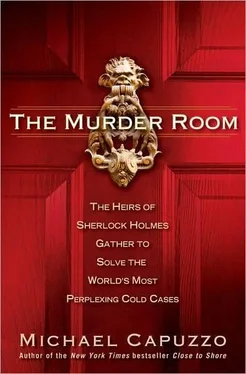Walter’s subtypes.
He and Bob Keppel, the famous Washington State investigator, had spent years refining their grand theory of murder investigation. They would soon publish in the International Journal of Offender Therapy and Comparative Criminology a paper, “Profiling Killers: A Revised Classification Model for Understanding Sexual Murder,” that would be internationally hailed as a landmark analysis and working system of murder investigation. Walter since the 1980s had been lecturing about murderer personality traits to detectives, prosecutors, and forensic specialists all around the world, from Hong Kong to London to Harrisburg, Pennsylvania.
It was a dream as old as the human condition, to understand the heart of darkness. To see the broader patterns. Walter hated to admit it, but his method was perfectly described in Beeton’s Christmas Annual in London in 1887, in the first appearance of Sherlock Holmes, who explains to his roommate, Dr. John Watson, what a “consulting detective” does: “… we have lots of Government detectives and lots of private ones. When these fellows are at fault they come to me… They lay all the evidence before me, and I am generally able… to set them straight. There is a strong family resemblance about misdeeds, and if you have all the details of a thousand at your finger ends, it is odd if you can’t unravel the thousand and first.”
In analyzing thousands of murders, Walter and Keppel discovered the most violent murders, sex murders, were invariably committed by one of four personality types. These distinct personalities inevitably expressed themselves, could not help but express themselves, their traits, desires, and learning curve in the murder itself. The crime scene was a vast canvas; the detective had merely to read the signature. Or, as G. K. Chesterton wrote in 1910, “The criminal is the creative artist, the detective only the critic.”
The thin man returned from the kitchen with a fresh pot of coffee, and Walter and Stoud both lit fresh cigarettes. Shortly after noon, they began the descent.
The first personality type of murderers identified by Walter and Keppel was the most common, the power-assertive or PA killer. Walter nicknamed this type the John Wayne-style killer. He bristles with machismo, muscles, tattoos, guns, girlie magazines, a pickup truck. He preens over his automobile. Among his signatures, he strikes massively to the head to overwhelm his victim, much like the first big bite of the great white shark. He disposes of his victim like trash, his power needs fulfilled. This is a man of ironclad principles (no character, but firm principles). For instance, if he’s raping and strangling a woman and she suddenly dies, he pulls out hurriedly because “he doesn’t want cops to think he’s a pervert,” Walter said. “Only a pervert would fuck a corpse.”
“Leisha Hamilton is a classic female PA,” Walter continued. “Scott Dunn unwittingly involved himself in an intolerable insult to power, and the PA annihilated him and disposed of him to sate her power need.”
Tim Smith, her collaborator in the murder, represented the seemingly gentler second type, the power-reassurance killer. He’s the Caspar Milquetoast killer, Walter said, lost in his own imagination. Instead of a brute grab for power, the PR killer achieved power through fantasy. This was the high school geek who skittered along the sidewalk robed in black, and turned horror movies into reality. This was the Gentleman Rapist who fantasized a strange woman was smitten with him, assaulted her with the line “Here I am at last, baby, open your wings,” Walter said, and flew into a murderous rage when “she let him know he wasn’t the best thing since sliced bread.” Unlike the John Wayne type, who scrupulously cleans the crime scene to avoid detection, this killer leaves a mess. Satiating the fantasy and rage is all that matters. James Patterson employed this type in his thriller novels, featuring characters such as Casanova and the Gentleman Caller in Kiss the Girls. David Dickson, the shoe-fetishist, was a power-reassurance personality who thought himself irresistible to women. When his fantasy was shattered by Deborah Wilson’s resistance to his charms, he murdered the Drexel student.
It was early evening, and Walter was sipping a glass of wine; Stoud’s thick hand held a can of beer.
For half an hour repartee and ragged laughter had penetrated a blue haze of smoke that drifted toward the crown moldings, as Rigoletto echoed through the parlor. Now they grew quiet. The tragic figure of Terri Brooks, beaten, strangled, stabbed, and asphyxiated, looked up from the nineteenth-century cherry side table.
“It’s an anger killing,” Stoud said. “All the violence, the percussion.”
“Indeed. This is darker, moving downward on the scale.”
It was the third type, the anger-retaliatory or AR killer, the first personality type to begin to take pleasure in the killing beyond the simple satisfaction of power. Stalking the victim from a distance, like predator chasing prey, and covering the victim’s face were two important AR signatures. Walter called the AR the O. J. Simpson-type killer.
“Although of course,” Walter said that evening, “we know that O. J. is an innocent man.” Stoud chuckled.
“This is classic AR, absolutely classic,” Walter said, “followed by a clumsy attempt, after the murder was done, to stage the crime as a robbery.”
The first sign of anger and passion was overkill, he said, as if Brooks had nine lives and the killer tried to extinguish them all. Next was the killer’s choice of intimate, close-up weapons-a knife, a lead pipe, and as an asphyxiation device, his bare hands. “If you and I have a dispute over my salary, and I decide to kill you, I’ll run and get my gun-it’s a power dispute; the killing can be clean and more emotionally remote,” Walter said. “But if it’s an affair of the heart, a betrayal, the murderer needs percussion, the cutting, stabbing, and beating, to achieve gratification.”
The AR killer’s pièce de résistance is to conceal the victim’s eyes. The killer of Terri Brooks did it with a plastic bag.
“In hundreds of cases I’ve looked at, an anger-retaliatory type will never allow the victim to view egress,” Walter said. “It’s a final expression of rage. A romantic relationship gone wrong is by far the most likely probability here. It’s the most logical because the overwhelming feature of the crime is the specialized-if you please, identifiable passion-and when you generally have passion, you have to have a reason for that passion, and sex is probably the most common one.”
Walter quickly developed a profile of the killer. “He’s an underachiever, but not without charm she finds quite appealing. She’s a nice strong woman, all the things he likes. He likes that tension back and forth, she allows him to be the immature little boy who never has to grow up. When she tires of his limits, in truth he’s a user and a loser, she thinks she’s ending her problem by getting rid of him, telling him to go peddle his papers, but now she inadvertently has signed her own death warrant because she’s no longer going to be there for him to use.”
He took a sip of wine. “Remember, with the AR the relationship isn’t over until they say it’s over. He’s quite pathological about it. Whether she wants to break it off or not, she doesn’t realize the fact of the matter is, he’s going to continue. He’s a parasite to her and has been all along, it just takes a more urgent, darker form. The coup de grace was ‘I don’t want you.’ When she cuts him off, he can’t stand it; that’s the justification. He feels righteously indignant. She has done him harm, therefore he has a right to kill her, therefore he hasn’t any guilt.”
Читать дальше












